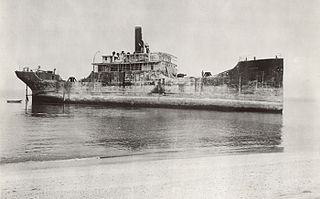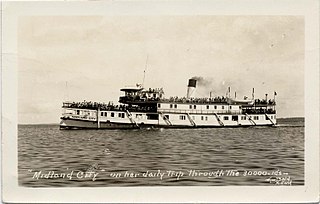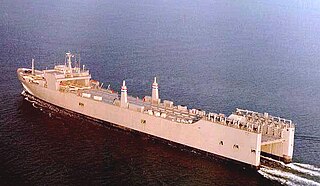History



The oldest known ferrocement watercraft was a dinghy built by Joseph-Louis Lambot in Southern France in 1848. Lambot's boat was featured in the Exposition Universelle held in Paris in 1855.
Beginning in the 1860s, ferrocement barges were built in Europe for use on canals, and around 1896, an Italian engineer, Carlo Gabellini, began building small ships out of ferrocement. The most famous of his ships was the Liguria. [5]
Between 1908 and 1914, larger ferrocement barges began to be made in Germany, United Kingdom, [6] the Netherlands, Norway and United States. [7] The remains of a British ship of this type, the auxiliary coaster Violette (built 1919), can be seen at Hoo, Kent, England. [8]
On August 2, 1917, Nicolay Fougner of Norway launched the first self-propelled ferrocement ship intended for ocean travel. This was an 84-foot (26 m) vessel of 400 tons named Namsenfjord. With the success of this ship, additional ferrocement vessels were ordered, and in October 1917, the U.S. government invited Fougner to head a study into the feasibility of building ferrocement ships in the United States. [9] [10] The Fougner Concrete Shipbuilding Company, Flushing Bay, New York, reported calculated cost was of $290 per deadweight ton for the Cape Fear (List of shipwrecks in 1920 "10.21 30 October") and the Sapona which they presumably built. [5]
About the same time, the California businessman W. Leslie Comyn took the initiative to build ferrocement ships on his own. He formed the San Francisco Ship Building Company (in Oakland, California), and hired Alan Macdonald and Victor Poss to design the first American ferrocement ship, a 6,125-ton steamer named the SS Faith. Faith was launched March 18, 1918. She cost $750,000 to build. She was used to carry bulk cargo for trade until 1921, when she was sold and scrapped as a breakwater in Cuba. [5]

On April 12, 1918, President Woodrow Wilson approved the Emergency Fleet Corporation program which oversaw the construction of 24 ferrocement ships for the war. However, when the war ended in November 1918, only 12 ferrocement ships were under construction and none of them had been completed. These 12 ships were eventually completed, but soon sold to private companies who used them for light-trading, storage, and scrap. [5]
Other countries that looked into ferrocement ship construction during this period included Canada, Denmark, Italy, Spain, Sweden [7] and the United Kingdom. [11]
Between the world wars, there was little commercial or military interest in concrete ship construction. The reason was that other shipbuilding methods were cheaper and less labor-intensive, and other kinds of ships were cheaper to operate. However, in 1942, after the U.S. entered World War II, the U.S. military found that its contractors had steel shortages. Consequently, the U.S. government contracted McCloskey & Company [12] of Philadelphia, Pennsylvania to build 24 self-propelled concrete ships. Construction started in July 1943. The shipyard was at Hookers Point in Tampa, Florida, and at its peak, it employed 6,000 workers. [13] The U.S. government also contracted with two companies in California for the construction of concrete barge ships. [13] Barge ships were large vessels that lacked engines to propel them. Instead, they were towed by tugs.
In Europe, ferrocement barges (FCBs) played a crucial role in World War II operations, particularly in the D-Day Normandy landings, where they were used as part of the Mulberry harbour defenses, for fuel and munitions transportation, as blockships, [14] and as floating pontoons. In 1940, 200 were commissioned to serve as petrol-carrying barges. The barges weighed 160 tons and were constructed on the London dockside before being craned into the water by a giant crane. [15]
Some barges were fitted with engines and used as mobile canteens and troop carriers. Some of these vessels survive as abandoned wrecks or sea defenses (against storm surges) in the Thames Estuary including near Rainham Marshes. [15] ) Two remain in civil use as moorings at Westminster.
One notable wartime FCB, previously beached at Canvey Island, was partially removed in 2003 by the local sailing club, whose land it was on, for fear it was a "danger to children". Local historians disagreed with the club and were displeased with their actions. [16]
In 1944 a concrete firm in California proposed a submarine shaped freighter which they claimed could achieve speeds of 75 knots. The war ended any more research into the project. In retrospect many believe the claims were greatly overstated. [17]
Concrete barges also served in the Pacific during 1944 and 1945. [18] From the Charleroi, Pennsylvania, Mail, February 5, 1945:
Largest unit of the Army's fleet is a BRL, (Barge, Refrigerated, Large) which is going to the South Pacific to serve fresh frozen foods – even ice cream – to troops weary of dry rations. The vessel can keep 64 carloads of frozen meats and 500 tons of fresh produce indefinitely at 12°F. Equipment on board includes an ice machine of five-ton daily capacity and a freezer that turns out more than a gallon of ice cream a minute. Three of the floating warehouses, designed for tropical warfare, have been built of concrete at National City, Calif., and cost $1,120,000 each. In the crew of the 265-ft. barges are 23 Army men.
One concrete barge under tow by Jicarilla (ATF-104) was lost off Saipan during a typhoon, and another barge damaged the Moreton Bay Pile Light in Brisbane, [19] but the rest served admirably. [20]



























